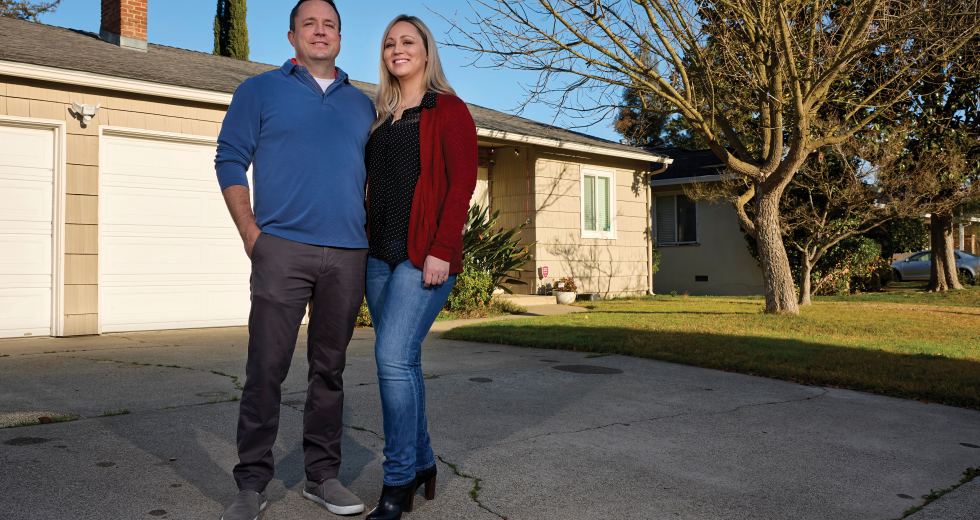In April 2021, Renee Edwards figured she and her husband, Jeremy, had finally landed the house they wanted in Carmichael, the 10th they bid on since they started looking a year earlier. On the previous nine, they offered more than the asking price with no contingencies — if a problem turned up during the home inspection, they wouldn’t require the seller to fix it. “That sounded so crazy, especially to my relatives,” says the 36-year-old elementary school teacher.
They had personal connections this time around. “There were friends on the street that were pulling for us and other friends that went to church with the (sellers) who were contacting them and saying, ‘This is a great family,’” Edwards says. It was listed at $720,000, “wildly higher than any other house on the street.” Still, they put in an offer $40,000 over asking. “I knew we were going to get it,” she says.
They didn’t. It went to someone who came in at $800,000. “After that, I said, ‘We can’t keep looking. We have to just stop this for a while because it’s so emotionally draining to get your hopes up,’” Edwards says.
But they kept at it anyway and got lucky two offers and a few weeks later on a house several blocks away. Their bid on that one had been rejected too — their 12th rejection in 12 tries. But the financing on the other buyer’s offer fell through and the seller was on a time crunch, so the Edwards got the house.
Behold the world of residential real estate, pandemic edition, where sellers reign supreme. The median sales price of a single-family home jumped from $386,000 to $505,000 between September 2019 and September 2021 in Sacramento County and West Sacramento, according to the Sacramento Association of Realtors. Average workers increasingly can’t afford a home. The annual Demographia International Housing Affordability Survey divides the median house price of a metro area by its median household income to derive an “affordability metric” — under 3.0 is considered affordable and anything above 5.1 severely unaffordable. Sacramento’s was at 5.1 in 2017 and 5.6 by 2021, which placed it 43rd of 56 metros nationally on affordability.
Still, the other six California metro markets included in that 2021 report ranked even lower. So for those migrating in-state, Sacramento is still a relative draw. Until now there’s been little indication that the run on homes is hurting local companies’ ability to hire and retain employees, say business leaders. But if prices keep rising at the record-breaking pace, all that could change and put business investments at risk.
Housing boom, Tahoe version
Consider the all-important manufacturing sector. “Manufacturers who are looking to put bolts in the ground to site large mass-scale production operations — one of the bottom lines that they look at in terms of cost and feasibility is housing costs for the workers,” says Gino DiCaro, senior vice president at the Sacramento-based California Manufacturers & Technology Association. The group’s data shows that California, which has 13 percent of the country’s population, got just 1 percent of investments of at least $50 million in manufacturing facilities for production in 2020. “The more housing costs increase, the more difficult it will be to grow here, stay here, retain and recruit workers here in Sacramento,” DiCaro says.
That future is now in the north Tahoe-Truckee region. Between November 2019 and November 2021, the median price increase for a single-family home across six jurisdictions was 53 percent — from about $707,000 to $1.1 million, according to Tahoe Sierra Board of Realtors’ data analyzed by Comstock’s.
“We lost affordable housing some time ago, but now we’ve even lost any kind of middle-income professional housing.”
Cindy Gustafson, supervisor, Placer County
“We lost affordable housing some time ago, but now we’ve even lost any kind of middle-income professional housing,” says Cindy Gustafson, who represents the area on Placer County’s board of supervisors. Restaurants can’t stay open the days they want because their employees can’t afford to live nearby. One business owner bought at least two trailer parks to house his staff and is helping employees with down payments; others bought homes to rent back to their employees, Gustafson says. “What I’m hearing from the business community, especially in North Lake Tahoe, is that this is a dire problem that employees cannot live anywhere near where they work.”
How we got here
When the pandemic hit, it looked like the start of a home price slump, says Erin Stumpf, Coldwell Banker Realty agent and president of the Sacramento Association of Realtors. Instead, prices shot up as sellers took their houses off the market because they didn’t want people in their homes. Buyers proliferated as people realized they wanted more space, maybe a yard and an office if they were going to work from home, she says.
Bay Area migration added to the mix, though it’s hard to say how much. About 20,000 households moved from the Bay Area to the Sacramento region in 2020, according to an analysis of U.S. Postal Service data by the Sacramento Business Review. There’s no data on how many of those also bought homes or what percentage of the region’s buyers they made up, and real estate pros don’t agree. Tim Collom, Realtor at the Tim Collom Realtor Group, says close to half of his firm’s 270 transactions in 2020 involved buyers from the Bay Area. But Rosanna Garcia, a real estate agent at Garcia Realty and a Sacramento Association of Realtors board of directors member, says 95 percent of buyers she’s worked with have been local. Whatever their number, Bay Area buyers bring with them practices that work in the Bay Area — like offers with no contingencies — which puts pressure on local buyers to do the same, Stumpf says. Mortgage rates that hit an all-time low in April 2021 added rocket fuel to the mix.
Beyond those, longer-term issues have kept prices high. Projects get slowed down by the construction labor shortage, and approvals for land development take years because they often need sign-offs from three levels of government (federal, state and local) or face NIMBY (not in my backyard) opposition and environmental lawsuits, says Michael Strech, president and CEO of North State Building Industry Association. Development impact fees, which are used to build the infrastructure, parks and schools needed when a housing project goes in, add $95,000 to the cost of each new home built in the Sacramento region — 18 percent of the house price, compared with 12 percent in the Central Valley, according to a May 2021 study for the NSBIA. (Seven Central Valley jurisdictions were included in the study, including Clovis, Fresno and Manteca.) “There’s a ton of demand and a lot of people that want homes, and that’s great for our business. But at the same time, it’s never been harder to build a house,” says Aren Bazzocco, Sacramento division president for home builder Taylor Morrison.
Is the run on houses helping business?
Still, it’s all relative — Sacramento County’s 30-percent spike may be an outlier, but home values are exploding across the country. Nationally, the Case-Shiller home price index jumped 25 percent between April 2020 and September 2021. Construction firms everywhere cite labor shortages, land use and zoning restrictions, and NIMBY opposition to development for the new-home shortage, according to Freddie Mac. “In a relative sense it’s certainly getting expensive here,” says Jeffrey Michael, executive director of the University of the Pacific’s Center for Business and Policy Research. “But it hasn’t necessarily changed the competitive standing of the area relative to other areas very much.”
And outside North Tahoe, businesses aren’t yet reporting that home prices have hurt hiring and retention. Hotels and restaurants have faced epic labor shortages nationwide. But Pat Mitchell, president at hotel management company Marin Management, says staffing has been less challenging in the Sacramento area and other Central Valley locations than in other areas of the state, which she attributes to housing costs that are more commensurate with hotel wages. Her firm manages three hotels in the Capital Region. And in the restaurant industry, unaffordable home prices affecting hiring “isn’t something we’ve heard about from our members,” says Sharokina Shams, vice president of public affairs at the California Restaurant Association. Chamber of commerce leaders consulted say they’ve heard little or nothing from their members linking home prices to hiring.
And one area business leader sees the sizzling market as a sign of the region’s dynamism. “The entire Bay Area moving here is just creating all kinds of economic opportunity with home selling and buying, and bringing new workers into our workforce,” says Joshua Wood, co-founder and CEO of the Sacramento Region Business Association and a member of Comstock’s Editorial Advisory Board. “This is great for business right now.”
“The entire Bay Area moving here is just creating all kinds of economic opportunity with home selling and buying, and bringing new workers into our workforce.”
Joshua Wood, co-founder & CEO, Sacramento Region Business Association
That’s certainly true for anyone working in construction and real estate. Scott Ford, president at consulting firm California Builder Services, is involved in a condominium project in Davis and says anyone in the trades is flourishing — he knows welders making $300,000 a year. Plus, builders are bulk-ordering supplies — say, 100 air conditioners at a time — which is pushing up warehouse lease rates, he says. Realtor Collom says since the pandemic hit, his firm has gone from four to five staff members in one office to 18 in two.
Plus, it’s still possible to land a house without cutthroat combat. John Clark and his wife, Jacqueline White, both in their late 30s, had an offer accepted in July 2021 in East Sacramento on their second bid. It’s in a good neighborhood but needed a little work, so it wasn’t perfect for people who wanted a place that was completely move-in ready, Clark says. They offered $20,000 over asking but got half of that back in negotiations over repairs.
There might also be a little help on the way in the form of new residential building. In 2020, more than 11,000 new building permits were issued on residential units in the Sacramento-Roseville-Folsom metro area — the most in any year since before the 2008 recession. That reflects new developments that are going up — like Folsom Ranch, set to add about 11,000 homes over 25 to 30 years, and Lagoon Valley, a master-planned “conservation community” outside Vacaville that broke ground in June 2021 and will add about 200 to 225 homes a year through 2026 or 2027, according to developers. And in August 2021, the Greater Sacramento Economic Council announced it’s launching the Community Reinvestment Coalition comprised of five community banks to make $100 million in financing available to address the area’s affordable housing crisis.
For all that, there’s little guarantee prices will stabilize anytime soon. Renee Edwards and her husband got to switch places when they put their own house on the market in May 2021 — a three-bedroom, two-bath on a good-sized lot on an arterial street in Carmichael. They listed the Thursday before Memorial Day weekend and went to Disneyland. A stampede followed: Stumpf, their Realtor, set up appointments to show it every half hour from 8 a.m. to 7 p.m. for three and a half days. “We probably had a hundred showings,” she says. “It was insane.”
When the Edwards family came home Tuesday, they had 13 offers and sold for $71,000 over asking to a Bay Area buyer.
“If I did have advice, it would just be that it does pan out the way that it’s supposed to — when a house finally does come, it’s the one that’s meant to be yours,” says Edwards — counsel that her friends were offering when she and her husband were having no luck. “Of course, I didn’t like to hear that when we were looking.”
–
Stay up to date on business in the Capital Region: Subscribe to the Comstock’s newsletter today.
Recommended For You

Powering Through the Pandemic
Local governments pull out all the stops to keep their economies rolling
Some solutions Capital Region governments have come up with
will stay around post-pandemic, which could further improve the
business climate.

Californians: Here’s Why Your Housing Costs Are So High
Here’s what you need to know about California’s housing costs, illustrated with infographics.

The Next Act
Part 6 of our ongoing series on downtown Sacramento businesses dealing with COVID-19
Sacramento businesses continue to adapt and recalculate as COVID-19 evolves.

Holding Pattern
Variety of local businesses shuttered by COVID-19 await reopening
Comstock’s has been following four businesses that have been helping to drive the resurgence of Sacramento’s central city in recent years. Here’s how they’re faring a month into the shutdown.

Shaking Up Real Estate
Tech firms aim to change the way we buy and sell homes — but take precaution
Opendoor and Amazon have entered the real estate market in Sacramento, and Zillow will expand here soon too, so it’s important to know how these companies work.




